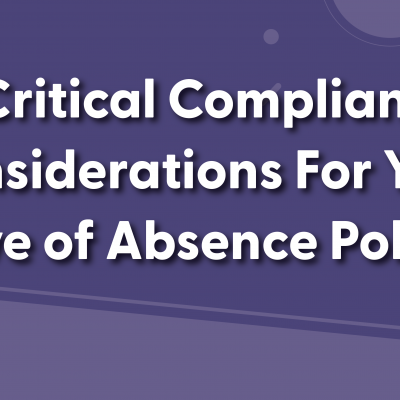While it’s advantageous to have an “all compliance considerations are critical ones” mindset, when it comes to evaluating your organization’s leave of absence policies and implementing them, there are a few atop the list that you should be paying extra special attention to. Making certain your policies adhere to various compliance regulations and standards will help ensure they are deemed fair, legally sound, and in accordance with the most recent labor laws.
Are Your Leave of Absence Policies Compliant?
Managing employee leaves of absence is a vital component of any organization’s HR efforts. From ever-evolving federal and state laws to anti-discrimination measures and documentation practices, there’s a lot for HR and People Ops leaders to navigate and consider.
Below we’ll delve into seven components to keep in mind when developing or updating your leave of absence policies. These considerations not only help protect employees’ rights but may also shield your organization from potential legal pitfalls.
1. Understanding Federal and State Leave Laws
The foundational pillar of any leave of absence policy, compliance with federal and state employment laws is paramount. On the federal side, stay well-versed with the latest updates to the Family and Medical Leave Act (FMLA), the Americans with Disabilities Act (ADA), and make sure you’re familiar with new legislation like the Pregnant Workers Fairness Act (PWFA).
Verify if your employees work in states that have state-specific regulations as they may introduce additional requirements. Non-compliance to these laws can lead to costly legal consequences and tarnish the organization’s reputation. Make it a priority to understand and align your leave management processes by crafting effective and legally sound leave policies.
2. Leave of Absence Anti-Discrimination Rules
Whether it happens intentionally or not, discrimination is a major compliance risk your organization may encounter if your policies aren’t factoring them into a potential reality. Preventing discrimination should be a core consideration for all leave of absence policies.
These policies should ensure the fair treatment of all employees fairly, irrespective of their race, gender, age, religion, disability, or pregnancy status. Discriminatory practices not only expose organizations to legal risks but also undermine workplace morale and inclusivity.
Process consistency should not be overlooked. Your policies should be administered uniformly to your entire employee population to stay out of legal hot water and to foster a discrimination-free work environment.
3. Ensuring Equal Employment Opportunity (EEO) Compliance
EEO compliance goes hand in hand with anti-discrimination efforts and is a cornerstone of equitable and lawful leave of absence policies. EEO laws, including the Americans with Disabilities Act (ADA), require organizations to provide reasonable accommodations for employees with disabilities. This means that when employees request leave due to medical conditions or disabilities covered by the ADA, organizations must engage in an interactive process to assess and potentially modify their leave policies to accommodate these employees.
EEO compliance goes beyond disability accommodations. It also involves ensuring that leave policies and practices do not disproportionately affect any protected groups based on race, gender, age, religion, or other characteristics. Discrimination or adverse impacts on certain groups can lead to legal liabilities and harm your organization’s reputation.
Make a plan to regularly review and adjust your leave policies to mitigate any potential disparities and ensure that all your employees have equal access to leave opportunities.
4. Leave of Absence Documentation and Recordkeeping
More than just an administrative nuisance (though they’re definitely that), documentation and recordkeeping in the context of your leave of absence policies are essential safeguards for both your employees and your organization. Comprehensive records serve as a vital resource in proving compliance with labor laws, especially in the face of potential legal disputes or audits.
Here are some of the items your records should include:
- Detailed information about leave requests
- FMLA information
- Approvals
- Denials
- Medical certifications
- Correspondence with employees
- Any relevant supporting documentation
Establish a robust and secure system for documenting all aspects of leave management, so in the event a dispute or an audit occurs, you have exactly what you need to demonstrate you’ve consistently applied your policies, treated employees fairly, and adhered to legal requirements.
In addition to legal protection, proper recordkeeping also enables your HR team to efficiently track employee absences, plan for workforce management, and provide transparency in leave-related decisions. It fosters accountability and builds trust among employees, assuring them that their rights are being upheld.
Ultimately, meticulous documentation and recordkeeping are integral components of responsible leave management, helping organizations navigate the complexities of compliance while creating a culture of fairness and transparency in the workplace.
5. Leave Management Notifications and Communications
Effective communication and a clear notification processes empower your employees to understand their rights and responsibilities regarding leaves.
The process begins with informing employees about the existence and specifics of your organization’s leave policies. Make it easy for them to be aware of the procedures for requesting leave, including any required forms or documentation. Transparent notification also extends to informing employees about the expected response time for leave requests and the expected duration of their absence.
In addition, though not required, organizations should maintain open lines of communication throughout the leave period. Identifying an employee’s preferred method of communication is paramount as regular updates and feedback can help employees feel supported during their absence and ease the transition back to work upon their return.
Communication should never be about work or leave the employee feeling like they should return to work prior to when they otherwise would. It’s also vital to address any questions or concerns your employees may have promptly and provide guidance on the process to follow while on leave.
A section on communication can’t overlook the role of the manager. Train them on the ins and outs of your policies, educate them on what they can and can’t say to employees, and make sure they don’t have access to confidential material.
6. Intermittent Leave Policy Tips
Intermittent leave policies might not be common within your organization, but when they do occur they require careful management to prevent abuse and ensure compliance with applicable laws.
You should establish clear guidelines for intermittent leave usage, which allow your employees to take leave in smaller increments instead of continuously. Effective management of intermittent leave can be challenging to do internally as it will potentially require meticulous documentation of start and stop dates and the tracking of hours, but is essential to uphold both employee rights and operational continuity.
7. Establishing Return-to-Work Policies
The heavy lifting of your leave of absence policies might revolve around successfully facilitating and documenting the leave request and leave journey, but without a soft and compliant landing back into the workforce your organization could still be exposed to compliance risks.
Your return-to-work policies should clearly outline the steps employees need to take when preparing to return. It should be noted that this may include requirements for medical clearance or documentation, depending on the nature of the leave. The policies should address the process of reintegrating the returning employee into the workforce, which may involve retraining, updating employees on any changes that occurred during their absence, or temporarily modifying their roles or schedules to accommodate their transition.
Moreover, your return-to-work policies should emphasize the legal obligation to reinstate employees to their original or equivalent positions, as mandated by the FMLA and other state and local laws that may have similar mandates.
An effective return-to-work policy is not only about compliance; it’s also about creating a supportive and seamless experience for employees as they rejoin the workforce. This can contribute to higher employee satisfaction, lower turnover, and a more productive work environment. It’s an essential element of responsible leave management that benefits both employees and the organization.
The importance of leave of absence policy compliance
Establishing and maintaining compliant leave of absence policies is not just a matter of ethical HR practice; it’s an essential legal responsibility for your organization. By adhering to federal and state laws, promoting anti-discrimination, documenting processes, communicating clearly, and addressing the needs of returning employees, your organization can create a robust framework that balances the well-being of your workforce with regulatory requirements.
Remember, compliance is an ever-evolving landscape, so it’s crucial to stay informed about changes in labor laws and adapt your policies accordingly. Regularly review and update your leave of absence policies, seek legal counsel when necessary, and foster a culture of fairness and flexibility within your organization. By doing so, you’ll not only mitigate potential risks but also promote a supportive and inclusive workplace environment where employees feel valued and protected.
About Tilt
Tilt is leading the charge in all things leave of absence management through easy-to-use tech and human touch. Since 2017, our proprietary platform and Empathy Warriors have been helping customers make leave not suck by eliminating administrative burdens, keeping companies compliant, and providing a truly positive and supportive leave of absence experience for their people.







